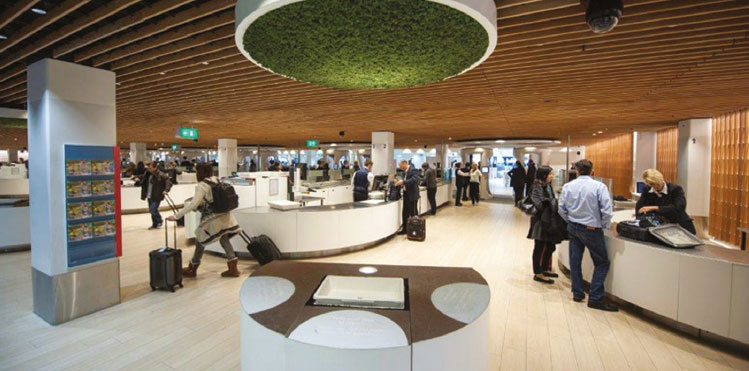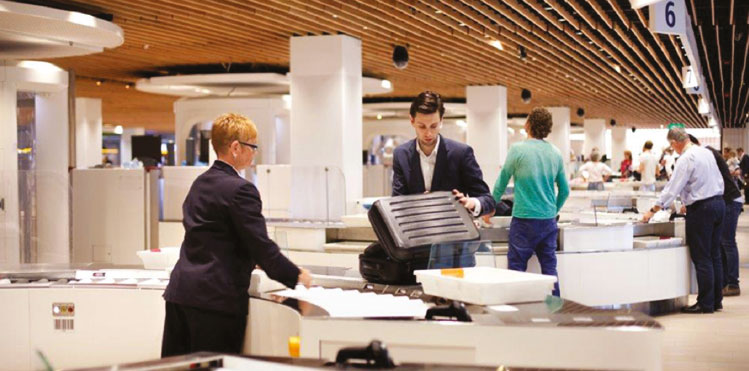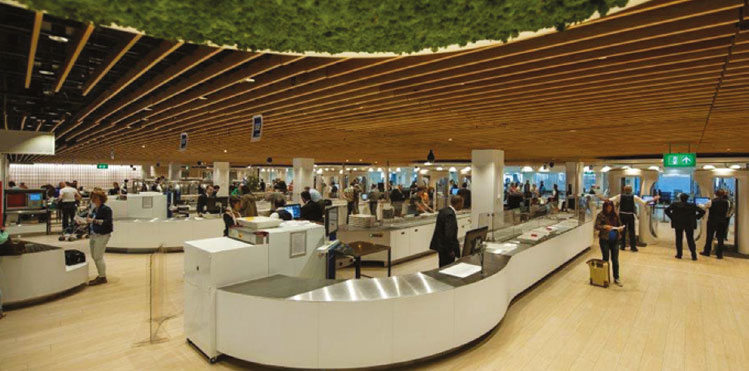
The use of white with wood tones, natural light, plants, and a curved lane design contribute to a more relaxing environment at the security checkpoint.
The completion of the project to centralise security at Amsterdam Airport Schiphol marked a key milestone in the airport’s wider ambition to create a more seamless experience for passengers and to deliver security not as a necessity, but as a service. Ryan Ghee reports.
The centralisation of the security checkpoints, which was completed on 3 June, presented Amsterdam Airport Schiphol with a significant task. To enable the transition to central security, an extra floor was constructed in Departure Halls 2 and 3 to accommodate new checkpoints, and in Piers E, F and G an additional level was built to separate passenger flows. The resulting three central security checkpoints for departing passengers and two for transfer passengers make for a far simpler and more intuitive experience for travellers, who no longer have to pass through one of 130 security lanes at the departure gate.
Central security itself is nothing new in Europe, but Amsterdam Airport Schiphol now boasts one of the world’s more unique airport security experiences. Gone are the slow-moving queues and sterile environment, and in their place is something referred to as the “Schiphol Security Experience”, which balances efficiency, stringent safety measures and customer experience, essentially delivering what has been labelled “security as a service”.
During a visit to Amsterdam Airport Schiphol ahead of the completion of the project, Airport Business explored the first 15 of the new-look security lanes in Departure Hall 1 first-hand to find out what difference they will make to the overall passenger experience. Ron Louwerse, Director Security at Amsterdam Airport Schiphol, explained that Schiphol Group’s philosophy is to view security “not as a necessity, but as a service.”
A unique security checkpoint
What is most striking about the new security checkpoint is that it feels very different to your average airport security screening zone. The use of white with wood tones, the natural light, the plants, the curved design of the lane all help to create a calmer atmosphere.
As for the process itself, up to three passengers can prepare for inspection simultaneously thanks to the larger preparation area, meaning the queues move faster, and use of Radio Frequency Identification (RFID) chips means staff can easily “mark” trays that may need closer inspection further along the line. If a member of staff needs to do a manual check of a cabin bag or other item, the divider sends the tray to a dedicated belt, which is visible through a glass screen so the passenger can still see where their bag is. Once they have passed through the scanner, those passengers whose cabin bags are cleared can make use of a re-composure area, where they can put on their coats, put their liquids, aerosols and gels (LAGs) back in their cabin bag and prepare to enter the departure hall at their leisure. The end result is a smoother, more seamless and calmer process.
Co-creation

There are now three central security checkpoints for departing passengers and two for transfer passengers, as opposed to 130 separate security lanes at the departure gates.
A number of stakeholders have played a vital role in making the Schiphol Security Experience a reality, including IATA, the Dutch government and KLM, in addition to suppliers such as Optosecurity, L-3 and I-SEC. Amsterdam-based Scarabee Systems & Technology has also been a pivotal player. The company developed the first physical prototype of the new security lane in August 2013, hosted multiple brainstorming sessions at its Security Experience Centre with all of the stakeholders to establish the requirements, compliancy and cost, and then continuously trialled the mock-up at its headquarters. After further prototyping, trialling, onsite user tests, performance tests and a final project evaluation, the lanes went live a little over a year after the development of that first physical prototype. By the end of this year, a total of 67 lanes will be in operation across the five central checkpoints.
Michael Tan, Scarabee’s President, said: “This co-creation approach allowed us to do things in a very short timeframe, although you always have to make alterations to make things perfect. Doing this together with other clients and stakeholders, developing confidence and expediting decision-making has been key, especially on a project that impacts the entire airport.”
He also explained that the newly designed security area is positively impacting the relationship between passengers and staff. “If you see that passengers are much more relaxed, it has a more positive effect on staff as well. It has created a better relationship. The passenger at the end feels much better, even excited. When you talk about security as a service, the passenger should be amazed by the experience. The human factor is paramount.”
Optosecurity, a long-time development and technology partner of Amsterdam Airport Schiphol, also had a key role to play and from the very outset worked alongside the airport project team and other partners on the design and delivery of the final solution.
The company’s eVelocity solution has already been deployed at 15 lanes as part of the VFilter1 project, enabling the airport to improve screener efficiency and performance, and optimise operations by reducing the number of screeners required. This is achieved by moving them away from the lanes and into a dedicated remote screening room, where they can view the X-ray images in a quieter environment.
Tim Mathews, President and Chief Operating Officer, Optosecurity, said: “By removing screening from the often noisy and busy environment of the lane itself, screeners can focus their attention on the X-ray image in front of them and make the best security decision possible. Likewise, having a dedicated team of screeners focused exclusively on the task at hand and working more efficiently means that fewer screeners are required to operate the checkpoint and cope with passenger flow.”
Mathews explained that the security filters now seem “less imposing and more service-oriented”. “The time spent waiting in line is significantly diminished by increasing efficiency of the security process,” he said, adding that Optosecurity has been firmly focused on enhancing the security process while maintaining the highest levels of security.

The “Schiphol Security Experience” balances efficiency, stringent safety measures and customer experience, essentially delivering what has been labelled “security as a service”.
Future proofing airport security
While the new-look security area has had an immediate impact on the passenger experience, Schiphol and its partners are also focusing on the longer-term. Sander Olivier, Policy Advisor for the National Coordinator for Security & Counter-terrorism at the Dutch Ministry of Security & Justice, explained that the “lane is designed to cope with future challenges”. “We need a system that can focus on new threats and existing threats,” he added. “We truly believe that passenger screening should be able to breathe with the threat, and the system should be flexible enough to do so.”
A number of so-called “SURE!” trials – national pilots led by the Dutch Government – are also currently being undertaken across Amsterdam Airport Schiphol, some with a view to creating a more risk-based security process using dynamic algorithms. Behaviour detection, Olivier added, could also help to enhance screening and expedite the process for low risk passengers.
Inspiring the industry
Airport security is a fluid process – it is ever-changing and airports, governments, suppliers and all other stakeholders must always be planning ahead, which is exactly what Schiphol Group and its partners are doing – and it is equally evident that Schiphol Group is committed to leading developments in this space.
The new-look security area makes a telling difference to the overall customer experience without compromising safety, and the complete centralisation of security at Amsterdam Airport Schiphol, coupled with the rollout of the Schiphol Security Experience, is certainly a step in the right direction.
Schiphol Group and its partners have now raised the bar to deliver security as a service. As Olivier aptly summarised: “We hope that airports around the globe will be inspired by what Schiphol is doing.”







